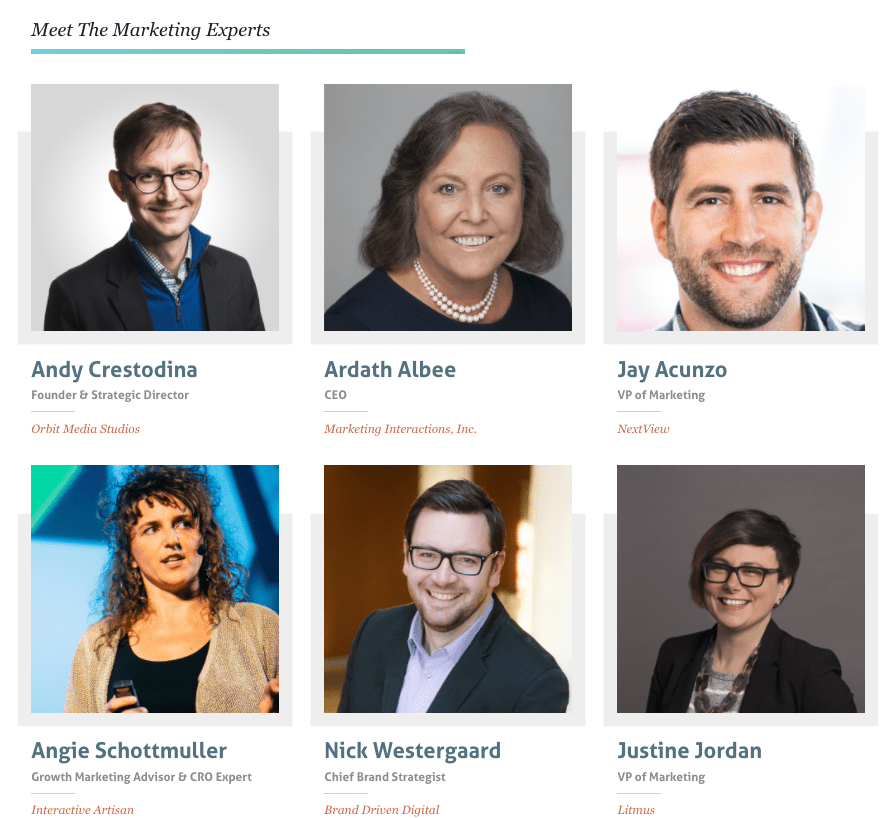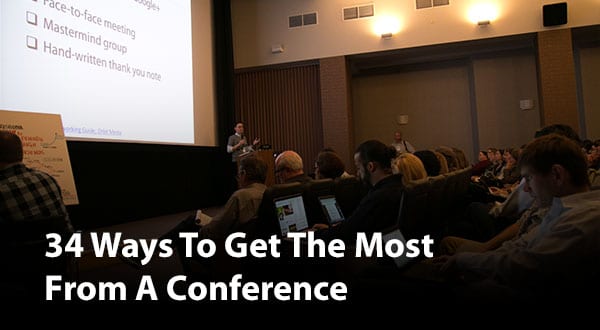The date is set. The venue is booked. Now you just need to get people to show up. Worried? Maybe a little? Don’t be.
If you’re not sure how to market an event, here’s a list of 50 event marketing tips. You don’t need a big advertising budget or celebrity endorsements to make this work. Just use this list as your event marketing plan. Here are our best practices for filling a room…
The event page (or website)
The cornerstone of all the promotion efforts is the event page or website. This could be a page or website specific to the event, or if you don’t have a site for the event, use an EventBrite page. Either way, make it compelling by including ALL of these elements:
1. Compelling description
Clearly indicate the topic, time, place and who should attend. The description should include specific benefits for each type of attendee. Make it brief and scan-able. Use third-party endorsements when possible, such as a quote from a previous event.
2. Pre-event curation of content
Curation of tangible content leading up to and/or during the event for event attendees to take away from the event (this could be videos, photos, t-shirts or just about anything.) Done right (not SWAG,) this can add to the buzz leading up to the event, tap new audiences for attendees and keep the event property top of mind to departing attendees. Content is about capturing great memories!
Editor’s note: We were missing a #2 for a while now (see comments below), but now we have one brought to you by Brian Ferber.
3. Speaker pictures and bios
Great speakers draw crowds like a magnet. The speaker page should show their faces and list their credentials.

4. Event image
The image will appear when the page is shared in the social networks. It could be the event logo, a picture of a room full of people, or just a genuine smiling face.
5. Event-related videos
Create simple video interviews of the speakers and post them here. These can be produced quickly using Google Hangouts or Skype. It’s easier than you think and very effective later on. If you ask nicely, maybe the speakers will make a little video for you, like Jay Acunzo, founder of Unthinkable, did for us for Content Jam.
6. Prominent “register now” button
Without a clearly visible button and a call to action, you might not get any action…
Pre-event email
If you have a list, email marketing may be your best channel. If you don’t, you may ask partners, speakers, or friends to mention the event in their emails (see “Affiliate Partners” below). Regardless of the list, use these event email marketing guidelines:
7. Subject line
Subject lines that inspire awe, anger, or anxiety lead to higher open rates. Studies have shown that subject lines with lukewarm emotional content are less likely to be opened. Try a subject line such as “10 things you miss if you aren’t at this event.”
8. Send during the weekend
Consider sending an email on the weekend. Since few companies do it, open and clickthrough rates may be higher. And when possible attendees see it on a weekend, they may feel less stressed for time and more willing to commit a few hours to your event. They may be in a social mood and even invite a friend.
9. Video thumbnail
Show a clickable image of a speaker interview video in the email. Video thumbnails in emails can improve clickthrough rates.
10. Social proof
If you have positive feedback from previous events or credentials for the speakers, use them as quotes in your emails and on the website.

11. Send and send again
Plan to send an event marketing email several times. For large events, email once months in advance to announce the speaker lineup and to announce early-bird registration discounts.
Email just before this discount ends, and again as the event approaches. Finally, send an email a few days before with reminders of time, place for registrants and a final pitch for new registration.
Pre-event social activity
Events are social occasions. So of course, your event marketing should use social media. Here’s how to promote the event with social media and blog posts:
12. The hashtag
Pick an event hashtag that’s short, and ideally, unique to your event. You’re going to always, always use this hashtag in every tweet and post.
ProTip: If you’re using Eventbrite, you can even use it in the address of the registration page as the subdomain. For example, Orbit runs a monthly event called “Wine & Web”. The hashtag is #wineweb and the registration page is wineweb.eventbrite.com.
13. Links in social media bios
Usually, your Twitter, Facebook and LinkedIn bios will link to your website. But when you’re promoting a big event, consider changing these links so they send visitors directly to the event page.
14. Find relevant people on Twitter
Use Twitter Advanced Search to find people who are interested in your topic and live nearby. Mention them in tweets about the event or tweet to them directly with a friendly invite.
15. Tweeeeeet!
Unlike email, most tweets are missed as they flow through the social streams of your audience. So tweet early and often. Here’s a list of reasons to tweet before the event. Many of these tweets can be scheduled far in advance, using tools like Coschedule and Buffer.
-
- Registration opens
- Early-bird registration is ending soon
- Countdown: “Just X days until the event!”
- Reminder of time and location
- Thank your sponsors (mention sponsors)
- “Just saw Jane’s presentation. Wow!” (mention speakers)
- “See you at the event!” (mention registrants)
- Thanks for sharing, posting and re-tweeting (mention anyone who shared)
- Tweets with a testimonial quote about a speaker (find these on LinkedIn)
- Tweet to the pre-event blog post using a quote from the interview. (mention speaker)
- “Thanks for registering! See you there!” (mention registrants, especially social media influencers)
16. …then follow people
After these tweets, follow a few people who may be interested in your topic. When you follow someone, you might get their attention and they may notice the event. It’s best to follow people when you have a compelling event promotion tweet at the top of your stream.
17. Post the event on Facebook and LinkedIn
Of course! Make sure that the image from the event page appears. Mention speakers, encouraging them to share it with their networks. Post again with videos and to remind people of registration deadlines.
18. Registration thank you page
On the thank you page after the registration process, offer to let them share the event on social media. The tweet will announce that they’re going and include the hashtag and the link to the registration page. Use a Click-to-Tweet link to make this easy. You can find more thank you page examples here.
19. Registration auto-response email
Once people register, they’ll receive an email. Use this as an opportunity to suggest they follow you on Twitter. Don’t forget to mention the hashtag.
20. Other auto-response emails
If your website can send people an email when they submit a contact form, add a link to the event here.
21. Cross the streams
If you find that you’re getting traction on one social network, but not others, move the conversation around. If someone shares something on Facebook, thank them on Twitter. If someone mentions the event on Twitter, say hi to them on LinkedIn.
As you can see, we’re recommending a lot social media activity, taking advantage of any excuse to connect, mention, post, tweet and link.
Pre-event blog posts
22. Write a pre-event blog post
A week in advance. Like the videos, this could be an interview with one or more of the speakers. Email interviews are an efficient way to produce content quickly. Just send a list of questions and post the answers when the speaker sends them back. Link to this post in the emails mentioned above.
23. Invite speakers to write guest posts
Speakers will recognize that although this takes a bit of time, there are SEO and social media benefits to guest blogging. If they do write something for you, encourage them to share that content with their networks.
ProTip: Do a guest blog post exchange with a speaker. Here is an example of how a content strategy event was promoted with two guest posts, one written by the speaker and posted on the event site, and another written by the event organizer on the speaker’s blog.
Working with partners
24. Photo and video partners
If you don’t have the budget to hire professionals, offer free admission (or even a table in the event space) to a pro photographer or videographer in exchange for services. Make sure they commit to providing you with assets in a reasonable timeframe. And make sure you give them good exposure in exchange for their time.
25. Standardize presentations
Create a standard Powerpoint template and share it with your speakers. It may only be two slides (a title slide and an interior slide) but it will have fonts and colors that match the event theme. This will help things look good later when you share the presentations after the event (see post-event email below).
26. Affiliate partners
Create a unique promotion code for each partner and speaker. They can use this code when they promote the event, offering a discount to people in their social networks. Since the code is unique to that partner, you’ll know how effective that partner was at promoting the event. Now you can pay them a referral fee to that partner for those registrants.
Example: Create a promotion code “BOB50” that gives $50 off to registrants. Share this code with Bob, your keynote speaker. Bob starts tweeting the code to his network and registrations start rolling in. In the end, the registration report in Eventbrite shows you the code was used ten times. Now you can write Bob a check for $500 (and a thank you card) for his help promoting the event.
Incentivize others to market the event for you as affiliates with promotion codes. This can be very effective!
27. Pre-written tweets
Don’t just encourage your sponsors, partners and speakers to help with promotion, make it easy for them. Write a list of compelling tweets and send them along in an email. Now they’re more likely to help and less likely to use the wrong link or hashtag.
28. Dinner and drinks
Invite speakers, sponsors, influencers and members of the press for a night out before the event. This is a chance to bond and have some fun. If you try this, you’ll likely find people referring to the dinner conversation during the event. “We were just talking about this the other night…” Strong personal connections may lead to better cohesion on the big day.
Submit to media and industry websites
29. Submit to local media outlets
Many media sites, especially the hyper-local news sites, let you post events. Find these by searching Google for “event calendars” in your city.
30. Submit to industry associations
Industry and trade associations may also allow you to submit. If the event is relevant to their audience, ask if they will accept, post or promote events from outside organizations. Chambers of commerce are often happy to promote events relevant to their members, especially if the organizers are members themselves.
31. Let the press know
There are likely journalists who cover local events. Find them by searching for similar events in news websites. Then graciously contact them with an invite, press badge or offer of a relevant article. This could be an interview with a speaker or a guest blog post from you for their website. If you successfully get their attention, you may get a bit of press!
Make your event page SEO friendly
People may be looking for your event right now! Follow these basic instructions to search optimize the event webpage or the Eventbrite registration page.
32. Target a keyword
First, we need to choose a relevant keyword. The target keyword should combine the event topic, the word “event,” and the name of your city. Examples: “orthodontist event Tulsa,” “campfire safety event Charlotte” or “vegan cooking event Chicago.” For tips on finding more specific keywords, take a look at this post: How to Research Keywords.
33. Title tags and headers
Use a title tag and header that include your target keyword. In the title tag, it’s best to put the name of the event last, so the keyword appears first. This helps indicate relevance to Google. For example, an event for veterinarians in Texas may benefit from a website with a title tag such as “Veterinarian Event in Dallas – PetCon Dallas.”
34. Search-friendly description
The event page should have a nice, detailed event description, which includes the keyword several times. If it’s long, break up the text into short, concise paragraphs. Use lots of formatting, including headers, subheaders, internal links, bullet lists, etc. You can find more advice on this SEO checklist.
35. Linking
Internal links are important for search engine rankings, so make sure to link to the event page from other pages on your site including older blog posts. This will guide visitors to the page, but also help search engines know that the page is relevant.
During the event
Live tweeting during events is a huge opportunity for event promotion. Registrants will be watching the hashtag, so fill that stream with interesting content.
36. Tweet quotes
Listen for juicy nuggets in conversations and in presentations. Mention the person who said it and use the hashtag.
37. Share pictures
Make sure to take pictures of people, speakers and attendees, as things are happening and share them on Twitter. Smartphones make this easy. Mention people and use the hashtag.
38. Hold a contest or drawing
Even if you’re giving away something small, like a book or a gift from a sponsor, use this as an opportunity to gather email addresses (with permission of course) and then share a picture of the winner holding the gift on the social networks.
The end of the event isn’t the end of the event marketing. After the event, follow up with activities that will make your next event an even bigger success.
Post-event blog post
Event recap blog posts are often easy and fun to write. Post them on the event site or submit them as a guest post to a relevant blog or local or industry/association website. They can include all kinds of relevant content.
39. Summary of presentations
These summaries can include quotes of positive feedback from a follow-up survey.
40. Speakers’ presentations
As with the photos, it’s ideal if the presentations are embedded into the event site or blog post using a tool such as Slideshare.
41. Gallery of event photos
Ideally, these galleries are embedded into the event site or recap blog post. If so, you’ll be sending traffic to your site, rather than a photo sharing website.
42. List the “top tweets” from the event
These are easy to find if you used a hashtag.
43. List the speakers, sponsors and attendees
List.ly is a very social way to build lists and embed them into a website. This kind of list may help attendees find each other afterward and get a better networking benefit from the event.
Post-event email
The email follow-up to registrants is a way to say thank you, share important links and keep a bit of buzz going…
44. Link to a survey
Surveys are a great way to get feedback, but they’re also a way to gather testimonials that you can use for future events.
45. Link to post-event blog posts
Since you already gathered up your best content and posted it, linking to it in these emails should be easy.
46. Invite registrants to follow you on the social networks
Some of your registrants may not follow you yet. Never miss a chance to promote your social media accounts!
47. Invite registrants to be notified of the next event
Some of your registrants may not be subscribed yet. Link to your email signup form to grow your list and promote your email marketing.
Post-event social activity
Now it’s time to share stories, say thank you and stay connected. Here are some social media activities.
48. Thank you tweets
Show your gratitude after the event by thanking the speakers, sponsors and attendees in follow up tweets and posts. This is good for networking.
49. Post photos
Put a few of your best photos on Facebook and Google+. Be sure to tag and mention people.
50. Keep sharing
In the days after the event, listen for tweets, mentions and blog posts from others. Hopefully, the hashtag makes this easy. When you see these mentions, share them!
Ready? Let’s do some event marketing!
We hope there are at least a few event marketing ideas here that you hadn’t tried before. If this seemed overwhelming, don’t worry. You don’t need to do them all. But the more you do, the fewer crickets you’ll hear. So get marketing! Those seats aren’t going to fill themselves.
And when the big day comes? Share these tips with your event attendees:
34 Ways to Get the Most From An Event
…it will encourage your audience to help you with marketing





